VMware’s New Partner Connect Program: 10 Things You Need To Know
VMware’s channel chief, Jenni Flinders, explains to CRN the ten things solution providers need to know about the company’s new flagship partner program: Partner Connect.
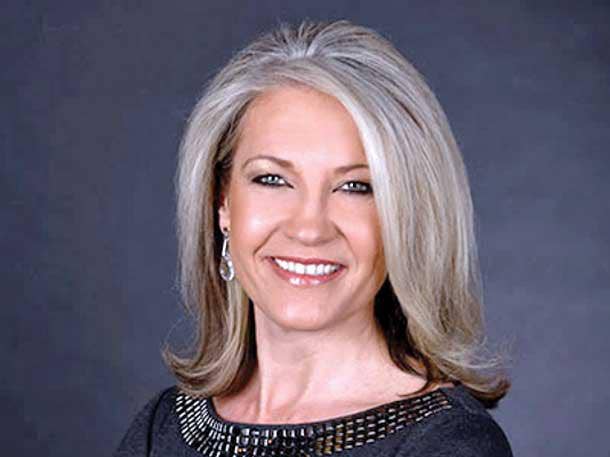
Welcome To A New Era In VMware’s Partner Strategy
For the first time in more than a decade, VMware has a new global partner program.
VMware Partner Connect officially became the virtualization star’s new flagship channel program on March 1 which makes all other VMware partner programs obsolete.
“If you looked at our portfolio, our solutions and offerings, and then the way the old program was going to market with partners – it was antiquated,” said Jenni Flinders (pictured), vice president and VMware’s worldwide channel chief in an interview with CRN. “We really wanted to build out our MSP capabilities with partners who are building repeatable IP and who are building integrated solutions with us. So it really required a complete reset of the partner program.”
VMware’s current flagship channel program, VMware Partner Network was unveiled in 2009. VMware Partner Network often did short-term adjustments, making how partners engage with VMware more complex. Partner Connect leaves behind the siloed and complex engagement frameworks with the goal of driving simplicity in a single program.
Flinders and Richard Steeves, senior director of Worldwide Partner Programs for VMware, tell CRN everything channel partners need to know about VMware Partner Connect.
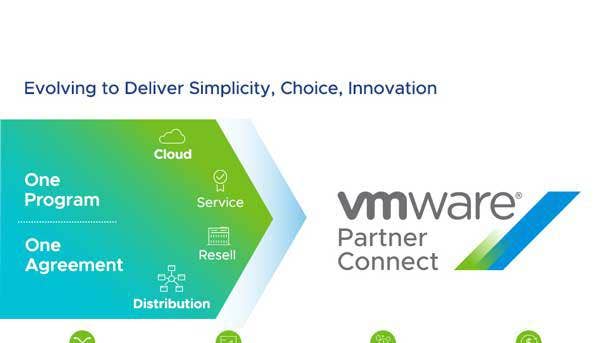
Simplicity: One Program, One Agreement
One of the biggest goals in Partner Connect is to make it simpler to work with VMware. Partners will now only need to sign one agreement with the vendor. Prior to Partner Connect, partners had to sign different agreements for each partner-type.
“It’s a complete transformation of all the systems of record, all of the systems of engagement, etc., and we’re anchoring the program experience off a more immersive and personalized digital experience for our partners in how they want to engage with VMware,” Steeves.
Flinders said VMware made a serious commitment when creating Partner Connect to make it simple to understand for partners.
“It was pretty difficult for partners to navigate and understand because of the way it evolved,” said Flinders. “If you were a partner part of our VMware Cloud Provider Program and also part of our Solution Provider Program, I know it wasn’t a good experience because it’s different requirements, different fee structures, different incentive models, different contracts, etc. What we’ve done is make it so much easier for partners where they have a single agreement with us.”

Integrated Pivotal, Carbon Black And VeloCloud Partner Programs
Since 2019, VMware has been on an acquisition tear, spending billions on Carbon Black, Pivotal Software, Veriflow, Uhana, Bitnami, BitFusion, Aetherpal and Avi Networks. These acquisitions range from endpoint security to artificial intelligence, providing VMware with an array of new technologies as well as partner programs within each vendor acquisition.
Over the next few months, VMware plans to integrate Carbon Black, VeloCloud and Pivotal’s channel programs into Partner Connect.
“As we bring in the Pivotal partner ecosystem, the Carbon Black partner ecosystem, we want to make sure those partners feel like they have a home that recognizes the investments they’ve made already,” said Steeves. “We’ve promised those partners who are already integrating across programs, that it will be a seamless transition and integration, and that we recognize the capabilities they’re bringing to the VMware ecosystem.”
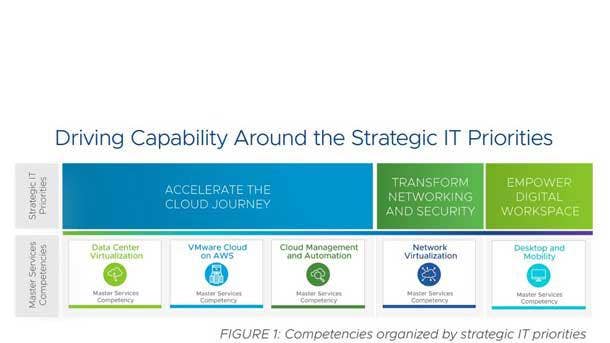
Master Services Competencies Are Key To Tier Status
First launched in 2018, VMware’ Master Services Competencies were designed to validate a partner’s capacity to deliver services related to a specific VMware technology. Channel partners will need to achieve Master Services Competencies in order to become a top-tier Principal Partner. Having these service competences enables partners to unlock additional rebates, deployment and consumption incentive opportunities.
The current Master Services Competencies available are Data Center Virtualization, Network Virtualization, Digital Workspace, Cloud Management and Automation, VMware Cloud on AWS, and its newest Cloud Native competency for Kubernetes. “We will continuously be keeping these competencies relevant,” said Flinders.
Partners attain a Master Services Competency by having the required number of individuals complete a set of advanced, solution-specific VMware certifications and submission of customer references.
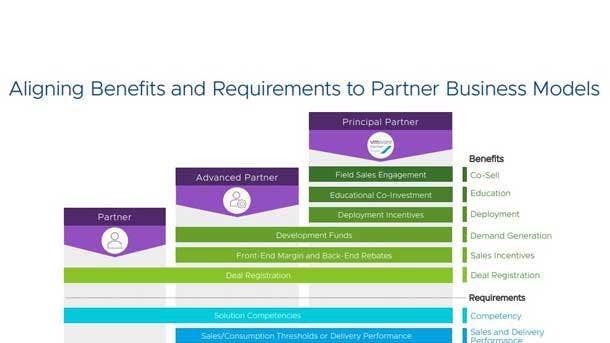
The New Three-Tier Program
There are three tiers in Partner Connect: Partner, Advanced Partner and Principal Partner.
For solutions providers in the lowest Partner level, a partner will only receive deal registration benefits. Channel partners who become an Advanced Partner receive development funding, front-end margin and back-end rebates, as well as deal registration. Solution providers who are Principal Partners get the same benefits as an Advanced Partner, as well as new co-selling field sales engagement, educational co-investment dollars and deployment incentives.
Under the former VMware Partner Network program, there were Professional, Enterprise and Premier tiers within the Solution Provider and Service Provider VMware Cloud Provider programs. VMware Partner Connect combines both the Solution Provider and Service Providers programs together.

Principal Partners Are The Go-To Partners For VMware
As of March 1, there will be more than 200 partners on a global basis who will earn Principal Partner status.
“We’ll put the full weight and brand behind their recognition as a Principal-tier partner in the program,” said Flinders. “It was designed specifically with customers in mind because we wanted to make sure we were putting the partners with the highest capability in front of customers.”
Only Principal partners who co-sell with VMware will have direct engagement with VMware field sales teams. These partners who have a proven services and deployment track record will receive additional investment from VMware as well as new deployment and consumption incentives. Key requirements to achieving Principal Partner status is owning Master Services Competencies as well as meeting sales and consumption thresholds or delivery performance.
“A big piece of this as we move forward, is continuing to make sure we make progress on rewarding those partners for the investments they make in the relationship,” said Steeves. “In terms of the reward opportunities, they’ll have increased opportunities aligned to their base rebates through solution rewards. So an increase to their [rebate] percentage.”

New Incentives and Development Funds Portal
VMware has created a new Incentives and Development Funds portal that provides enhanced dashboards and visibility to track their activity with VMware. The role-based portal will allow VMware to deliver more relevant content to the partner depending on their individual roles.
“So on March 1, partners will now see an entirely new portal. Within that, is a completely reinvigorated rewards portal that allows a partner the ability to customize the consoles and gives them visibility in how they’re managing their rewards opportunities with VMware, particularly around development funds, tracking, access, unitization, etc.,” said Steeves. “Through the rewards portals, the enhancements we’re working through the myLearn portal, and through the Partner Connect portal transformation -- it’s a seamless, innovative experience that is mobile responsive and is personalized based on an individual’s role in the company.”
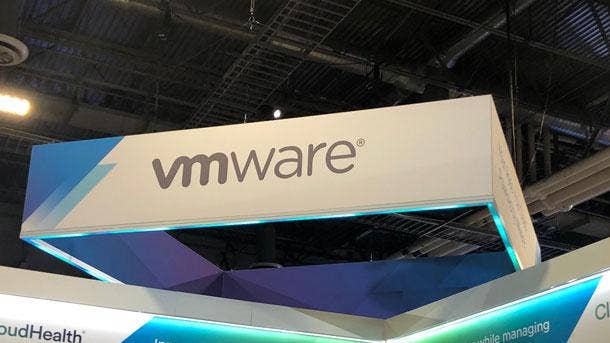
New VMware Learning Zone
The new VMware Learning Zone provides a variety of content for the channel, including the ability to customize learnings plans based on individual partner preferences.
“Partner individuals wanted greater visibility into their tracking towards certification,” said Steeves. “We’re giving partners the ability to look across the capabilities within the company. It’s a huge modernization. So both the online experience, the course tracking, the certification completion – all of that is being transformed.”
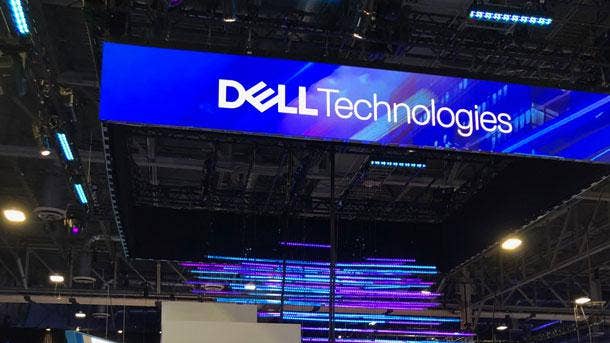
No Ties To Dell Technologies Partner Program – Yet
VMware is a member of the Dell Technologies family of businesses, with Dell owning a majority stake in VMware stemming from its $67 billion acquisition of EMC in 2016. Last year, the company ended its Dell EMC Partner Program, replacing it with the Dell Technologies Partner Program. The new program enables partners to more seamlessly sell, get certified and trained, and procure solutions across Dell, Pivotal, SecureWorks and VMware.
However, at this time, VMware said Partner Connect has no direct ties to the Dell Technologies Partner Program.
“There isn’t a hard connection between the two programs,” said Steeves. “But what we are doing – and this is something we’re doing in collaboration with [Dell Technologies worldwide channel chief] Joyce Mullen and [Dell’s senior vice president of global partner marketing] Cheryl Cook – is we want to do a better job in recognizing the capabilities that partners make across that Dell Technologies family.”
Although Steeves said there’s “nothing at the moment” in terms of synergies between the Dell Technologies and VMware Partner Connect programs, there might be some connections in the near future.
“As we look at Dell Technologies Cloud on VxRail, for example, how do we think about aligning certifications and competencies so that a partner can make an investment in any-one program and receive the benefits across the programs,” said Steeves. “We’ll probably expand that through the years. I’ll expect we’ll have something to share in the Dell Technologies World [2020 conference] timeframe.”
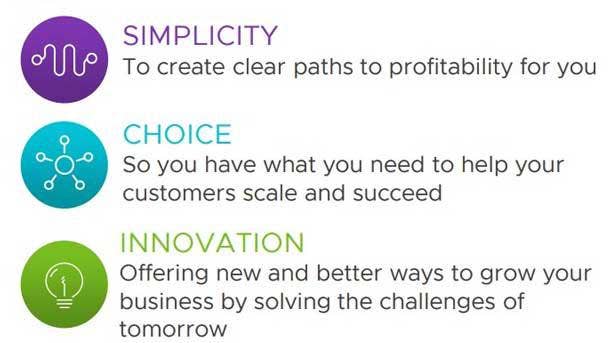
Partner Connect: Designed For Any Business Model
The new program was designed to align to each individual solution provider’s business model. Partners can now specialize in a certain aspect of VMware technologies – such as hybrid cloud, network and security, application modernization, or digital workspace – without needing to fulfill other VMware requirements that do not align to a partner’s business strategy.
“It really comes back to the core tenant of simple. Through one program, regardless of business model, you can gain access to the full breath of the portfolio -- that’s the guiding principal,” said Steeves. “With other programs in the industry, you have to have both the breadth and depth to move up and progress through the program. We wanted recognize that we have an healthy ecosystem of mobility-centric partners, so let’s give them a pathway of differentiation through a program that doesn’t hinge on their ability to drive one market segment like network virtualization, for example. Partners get to choose their own adventure in the program. They get to differentiate based on their investment strategy and business model.”
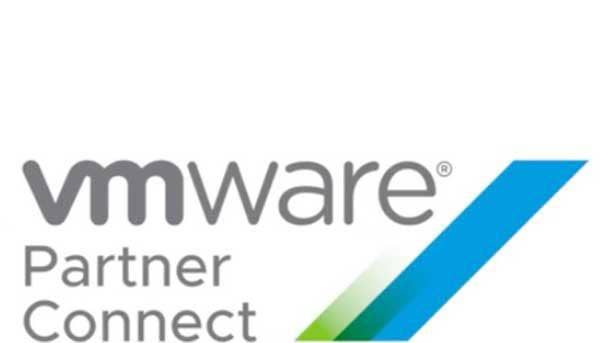
Here's Why Partner Connect Was Launched in 2020
The launch of Partner Connect comes on the heels of VMware reinventing itself through both organic and inorganic innovation such as its push into Kubernetes, software-as-a-service and its bullish acquisition of Carbon Black. Additionally, the increasing complexity of customer requirements require a more simplified engagement with VMware, according to Flinders.
“The old program was very transactionally-focused. This new one now centers around the customer journey and VMware’s journey to transition to SaaS and subscription. It’s a huge transformation,” said Flinders. “It’s the best time right now to be a VMware partner. If you look at our solution portfolio, no matter where you focus on driving customer outcomes, we lead across all these strategic IT priorities in the industry. The acquisitions that we’ve made have only strengthened our IT priorities and strengthened the solutions that we can take to customers with our partners. There is no better time than right now to engage with VMware and take our solutions to market.”